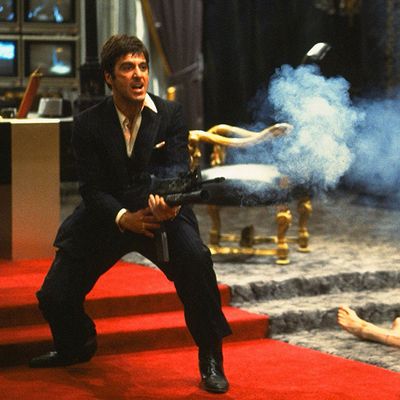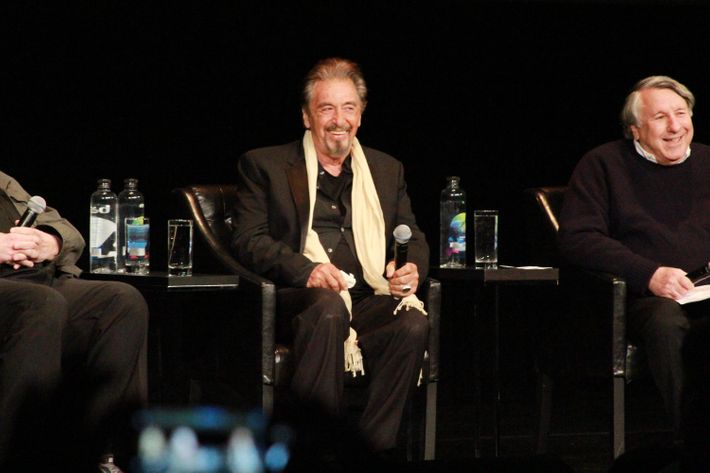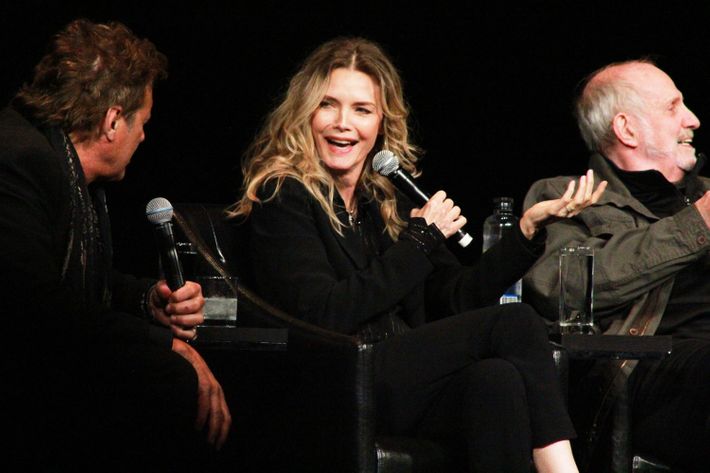
“This wasn’t the way it started,” Al Pacino chuckled, during the sold-out post-screening Q&A for the 35th anniversary screening of Scarface at the Tribeca Film Festival last night. “When Scarface first came out, it was extremely controversial, as you can imagine. But it stays in our lexicon, in a way. It’s part of our culture.”
It’s certainly a case of a motion picture’s half-life far exceeding its initial expectations — which were no doubt colored by a flurry of bad press and reports of a production veering wildly out of control. The resulting film, a baroque bacchanal of splattering blood, voluminous blow, and unapologetic scenery-chewing, was decidedly of its moment; its fashion, its synthesizer score, and its coked-dusted “everything to excess” aesthetic practically plaster “EARLY ’80s” into every frame. But its themes and preoccupations, the way it gets at the rot deep in the core of the American Dream, continue to reverberate.
The origins of the project vary, depending on who you’re asking (and when). Reporting from around the time of Scarface’s 1983 release pegged it as a pet project of Martin Bregman, the talent agent who transitioned into producing with Serpico and Dog Day Afternoon, both developed for his client Al Pacino with director Sidney Lumet. A chance late-night TV viewing of the original 1932 Scarface — Howard Hawks’s tale of bootlegging Chicago gangsters, inspired by the exploits of Al Capone — got Bregman’s wheels turning. He instantly thought of Pacino for the leading role, the story goes, and engaged Lumet to again direct.
However, in recent interviews, Pacino has claimed he got the idea after a revival screening of the original movie at the Tiffany Theater in Los Angeles. “I went and saw that film and called Marty Bregman after,” he said at a Q&A in 2011. “I said, ‘I think we could do this thing. There’s a remake here.’” Whichever story is true, Bregman next reached out to Oliver Stone (then best known as the screenwriter of Midnight Express) about penning the script. Bregman had attempted to produce Stone’s Born on the Fourth of July screenplay for Pacino, so there was a relationship in place, but Stone was initially uninterested in Scarface.
“I didn’t want to do an Italian Mafia movie,” Stone tells Matt Zoller Seitz in the book The Oliver Stone Experience. “We’d had dozens of these things. But then Bregman came back to me and said, Sidney has a great idea — he wants to do it as a Marielito picture in Miami. I said, That’s interesting! Sidney’s idea was a good one.”

“Sidney’s idea,” which Stone adapted into the film’s opening crawl, went like this: In the spring of 1980, roughly 125,000 new Cuban exiles departed the Port of Mariel for the shores of Florida. A fifth of these Marielitos were rumored to be “undesirables,” petty thieves and worse, released from Cuban prisons and mental institutions and sent to the States as a middle finger from Castro.
Intrigued by the hook, Stone took the assignment and spent two months in South Florida doing research — and coke. “I started to hit the trail in ’79, and continued till ’82,” he told Seitz. “I don’t think my writing benefited from cocaine, but I did write Scarface completely sober.” He holed up in Paris to do so, away from the chemical temptations of Miami and L.A., and banged out a Stone special: big, boisterous, provocative, and operatic. Everyone was wild about it except Lumet, who departed the picture due to that old standby, “creative differences”; all Bregman would say at the time was, “Lumet wanted to make one kind of movie and I wanted to make another.”
Enter Brian De Palma. Asked why he stepped into the picture as a gun for hire in 1983 (he usually originated his own projects), the Carrie and Dressed to Kill director gave two reasons: “I’ve always wanted to make a gangster picture and I’ve always wanted to work with Al Pacino.” Pacino had mentioned the film when he met with De Palma about working together on Blow Out, though John Travolta ended up starring in that one; its commercial failure was a big motivator for De Palma taking on Scarface when Pacino and Bregman came calling. Both of the projects the filmmaker was developing to follow Blow Out — a dramatization of the 1969 murder of labor leader Joseph Yablonski and an adaptation, again with Travolta, of the nonfiction NYPD corruption exposé Prince of the City — fell apart. (He and Lumet ended up switching projects; after De Palma was dismissed from Prince of the City, Lumet made the picture with Treat Williams in the lead.) De Palma figured he’d knock out this highly commercial gangster movie and get back in the industry’s good graces. Should be an easy gig, right?
“Spokesmen for Miami’s Latin community are reportedly nervous at the potential bad image that could result from the movie Scarface, now heading into production,” went the item in the August 4, 1982, issue of Variety, the first public indication of the controversy that had been simmering since Scarface set up its production office in the city earlier that summer. The producer and studio commenced a rotation of private negotiations and a public PR battle over the film, with the mayor’s office uncomfortably in the middle (representative Marylee Lander told Variety, “It’s just a gangster movie set in Miami … We’ve never seen our office with a censorship role.”)
City commissioner Demetrio Perez led the charge against the picture, while Miami Herald columnist Guillermo Martinez penned an editorial voicing their main concern: that the stories of the Marielitos were fueling anti-Cuban sentiment in Florida, which would be further amplified by a film that would “tell the nation and the world that the prototype of the U.S. gangster of the 1980s was a Mariel refugee.” (In a New York Daily News editorial following the film’s release, Miguel Perez charged, “the movie fails to say that even among those Marielitos who had criminal records, there were thousands whose offenses were so minor that they would not be considered criminals here, and thousands of others whose ‘criminal record’ was based on their opposition to the Communist regime.”)
“Well, Tony Montana was a gangster,” Stone explained to Seitz. “His mother and his sister represent the clean-cut Cuban community. His mother scolds him: You’re a scumbag, get out of my house! You’re ruining your sister! So there is a strong morality in the movie. I knew about the criticisms even in advance, that Cubans were not like that. But I’m sorry: A lot of Cubans did become Marielitos. If I’d done it about Colombians, they would’ve said the same thing: You’re anti-Colombian.”
Bregman and his production team met with local leaders throughout August, while simultaneously (and quietly) weighing the option of diverting the shoot to California. Bregman publicly insisted he wouldn’t budge, though his pronouncements were undercut a bit when Universal president Ned Tanen told New York Daily News gossip columnist Marilyn Beck, “Universal won’t make the movie there unless I can be assured there will be no problems. They last thing I need is to end up having militants chasing us around the block.” By the end of the month, the producers finally got the go-ahead, though with several strings attached (including a closing disclaimer, which remains in the film, that “the vast majority of Cuban/Americans have demonstrated a dedication, vitality, and enterprise that has enriched the American scene”). But by then, it was too late; on September 1, Variety reported that Bregman and Universal had decided to move the bulk of the production to California “as a result of opposition from within the local Cuban community.” (They would ultimately shoot ten days of exteriors in southern Florida the following spring, with that schedule kept tightly under wraps to avoid the kind of disruptions that had plagued Pacino’s last cause célèbre, Cruising.)
Not that the relocated shoot, which began in November of 1982, was smooth sailing from there. The production was twice halted by major weather interruptions in California. In March, Pacino tripped during a fight scene and fell on an M14 machine gun — burning his left hand on the muzzle of the gun, which had just been fired. Pacino was rushed to the Sherman Oaks Burn Center (his doctor there had operated on Richard Pryor following the comic’s self-immolation in 1980), and production was shut down for more than a week while Pacino recovered. (And then a premature bomb explosion injured two stuntmen during a scene shot in his absence.) On top of all that, in a September interview with Women’s Wear Daily, De Palma blamed the movie for the dissolution of his marriage to actress Nancy Allen; the extended shoot had kept them apart for months, and he believed Allen, who had co-starred in his last three movies, was bitter he’d cast newcomer Michelle Pfeiffer in the lead of this one. (“I didn’t cast her because she wasn’t right for the part,” he said. “I’m a director, I have to make choices.”)

“The movie was a nightmare to make, went three months over, and I was on that set all the way to the end,” Stone recalled. “They kept me there. It was like, Who do you have to fuck to get off this ship? It was so slow the way they made it, because Brian’s not an energy guy, and Al’s a retake guy. It cost too much, went over, and was a black sheep from the get-go with Universal.”
Originally projected as a $10–$15 million project, its final budget landed somewhere between $23 million (according to Newsday) and $37 million, the number that made it from gossip columnist Cindy Adams’s column to the pages of Variety — much to the chagrin of Bregman, who demanded a retraction from the trade paper. He had reason to be sensitive; no one wanted the bad press of a runaway production in an industry still reeling from Heaven’s Gate and One From the Heart, blank-check projects from acclaimed ’70s filmmakers like De Palma that had careened over budget and failed to recoup the films’ costs. DePalma, however, was unapologetic; when asked about the issue by Women’s Wear Daily, which reported the budget as $26 million, he shrugged, “I’m giving them a three-hour gangster picture with Al Pacino.”
But whatever the number, Scarface needed to do big business to go into the black — which is part of why its makers panicked when, on October 28 (less than two months before its release), the MPAA slapped it with the dreaded X rating. “We have been designated as a pornographic film,” Bregman fumed to the Times. “We’ll accept the X rating and appeal.” When the news broke, De Palma had already recut the picture three times, but the ratings board maintained that the film deserved the adults-only rating, for “excessive and cumulative violence and for language”; the director threw up his hands and told the studio he wouldn’t cut it any further. They’d have to fire him and find somebody else to do it, or take the X.
There was precedent for the ratings trouble: The original Scarface was reworked greatly to satisfy the Hays Office, and was nevertheless banned by several states. But the clock was ticking, and several theaters in Los Angeles were already advertising the film as rated R. Universal couldn’t release the film with an X — aside from the porn perception and the chunk it would take from their pool of ticket buyers, most newspapers, TV, and radio stations wouldn’t run ads for an X-rated movie. But the troubled production also couldn’t risk additional bad press they’d incur by ousting a name director and recutting his film against his wishes. “I said I’ve had it with these people, I’m not taking any more out,” De Palma recalled at the Tribeca screening. “And I told Marty, and Marty said, ‘We’ll go to war with these people.’ And that’s what we did.”
They argued their case for an R in front of the MPAA’s appeals board, made up of theater owners, distributors, and execs. Before they did, De Palma restored the footage he’d excised to please the MPAA, deciding, “We’re gonna put the movie exactly the way I originally cut it. I got an X on the third, I got an X on the second, I got an X on the first. We’re going with the original version.” They were rolling the dice, and on November 9, exactly one month before release, it paid off — the ratings board overturned the X and designated the film an R. “It was one of the great moments that we had,” De Palma recalled. “We beat the censor board.” Now they just needed the movie to be a hit.
Scarface premiered on December 4 at the National Theater in New York, in advance of its December 9 release to 1,000 theaters across the country. The day before, the Daily News’ Marilyn Beck reported “a rather underwhelming response to the picture” at industry screenings, and the critical notices were, for the most part, far worse. New York’s David Denby shrugged, “Scarface has a few brilliant scenes, but it’s dismayingly empty … a sadly overblown B movie.” The Village Voice’s Andrew Sarris dismissed it as “camp for the coke crowd.” The New York Post’s Rex Reed deemed it a “pointless bloodbath” that aimed only to “disgust, sicken, and horrify the audience with a rampage of violence, bloodshed, and carnage.” Even DePalma’s usual partisan Pauline Kael couldn’t muster up much enthusiasm; she called it “a long, druggy spectacle — manic yet exhausted.” There were kinder reviews (from the New York Times, Roger Ebert, and the San Francisco Chronicle, most notably), but not enough to boost the receipts; it opened in second place behind Clint Eastwood’s Sudden Impact, topped out at $45 million domestic (not enough to cover costs), and that was that.
But it wasn’t. It landed on VHS and Betamax the following summer, at what may have been the perfect moment, as home video reached a penetration point and videotape rentals were becoming part of the average moviegoer’s diet. Scarface became one of the first runaway hits of the home-video age, shipping more than 100,000 units upon its initial release (at $79.95 a pop) to add a robust $4 million to its coffers, and selling steadily on tape and disc in the following years; its 2003 20th anniversary edition DVD (which followed a ten-city theatrical rerelease) became the fastest-selling live-action catalogue title of the format to date, moving 2 million units in its first week, outpacing previous champ E.T. Back in 1983, few would’ve believed that Scarface would best E.T. at anything.
On video, the film found its most receptive audience — younger viewers who wore out their tapes (in a retrospective documentary, Sean Combs claims to have seen the movie 63 times “for the lessons”), memorized lines of dialogue, and made them their mantra. “It is Scarface’s impact on the fantasy lives of urban moviegoers — the subcult that creates the fashions, music, lingo, and news fodder for the rest of the country — that has helped extend the greed of the Reagan ’80s into the new millennium’s social desperation,” wrote the New York Press’s Armond White, on the film’s 20th anniversary. It was, by then, a touchstone in the hip-hop community, where shout-outs and samples from the film are ubiquitous. T-shirts flew off flea market shelves; posters became dorm-room standbys. Pop-punk band Blink-182 took its name from the number of times Pacino says “fuck” in the film.
Watching Scarface now, its striking style and epic scope are nearly eclipsed by the cultural descendants — Public Enemy’s “Welcome to the Terrordome,” Ice Cube’s “Today Is a Good Day,” Jay-Z’s “Can’t Knock the Hustle,” or Nas’s “The World is Yours” — that echo through it. Tony Montana may take a bloody header into the indoor pool before the credits roll, but he’s far from gone; the extent to which he’s affixed himself to the American psyche, how we’ve seen his ruthlessness and recklessness reflected not just in crime or pop culture but the unapologetic world-is-mine grift riff that’s somehow infested the Oval Office, hints that maybe its original go-go ’80s audience wasn’t quite ready to accept the psychological and sociological truths that were hiding just under Scarface’s shiny surfaces. Maybe we’re more willing to examine them now. Or maybe we’re just at a safe enough distance to obscure them with the lens of nostalgia.

